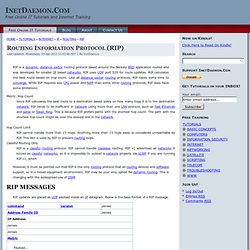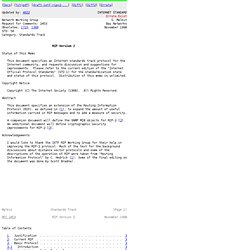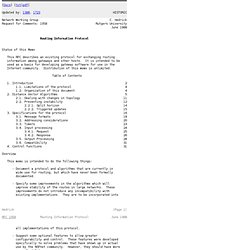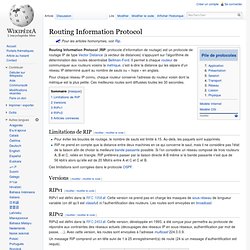

B1-routage.PDF - Powered by Google Docs. Spip. Routing Information Protocol (RIP) RIP is a dynamic, distance vector routing protocol based around the Berkely BSD application routed and was developed for smaller IP based networks.

RIP uses UDP port 520 for route updates. RIP calculates the best route based on hop count. Like all distance vector routing protocols, RIP takes some time to converge. While RIP requires less CPU power and RAM than some other routing protocols, RIP does have some limitations: Metric: Hop Count Since RIP calculates the best route to a destination based solely on how many hops it is to the destination network, RIP tends to be inefficient in network using more than one LAN protocol, such as Fast Ethernet and serial or Token Ring. Hop Count Limit RIP cannot handle more than 15 hops. Classful Routing Only RIP is a classful routing protocol. However, it must be pointed out that RIP is the only routing protocol that all routing devices and software support, so in a mixed equipment environment, RIP may be your only option for dynamic routing.
Routing Information Protocol / protocole RIP. RIP : Routing Information Protocol. Internetworking Technology Handbook - Routing Information Protocol (RIP) Rfc2453. RFC 2453 - RIP Version 2. [Docs] [txt|pdf] [draft-ietf-ripv2-...]

[Diff1] [Diff2] [Errata] Updated by: 4822 INTERNET STANDARD Errata Exist Network Working Group G. Malkin Request for Comments: 2453 Bay Networks Obsoletes: 1723, 1388 November 1998 STD: 56 Category: Standards Track Status of this Memo This document specifies an Internet standards track protocol for the Internet community, and requests discussion and suggestions for improvements. Please refer to the current edition of the "Internet Official Protocol Standards" (STD 1) for the standardization state and status of this protocol. Distribution of this memo is unlimited. RFC 2453 RIP Version 2 November 1998 Table of Contents 1. RFC 2453 RIP Version 2 November 1998 1. With the advent of OSPF and IS-IS, there are those who believe that RIP is obsolete. 2. The current RIP-1 message contains the minimal amount of information necessary for routers to route messages through a network. 3. 3.1 Introduction 3.2 Limitations of the Protocol.
RFC 1058 - Routing Information Protocol. [Docs] [txt|pdf] Updated by: 1388, 1723 HISTORIC Network Working Group C.

Hedrick Request for Comments: 1058 Rutgers University June 1988 Status of this Memo This RFC describes an existing protocol for exchanging routing information among gateways and other hosts. It is intended to be used as a basis for developing gateway software for use in the Internet community. Distribution of this memo is unlimited. Table of Contents 1. RFC 1058 Routing Information Protocol June 1988 all implementations of this protocol. - Suggest some optional features to allow greater configurability and control. 1. This memo describes one protocol in a series of routing protocols based on the Bellman-Ford (or distance vector) algorithm. RFC 1058 Routing Information Protocol June 1988 systems. RFC 1058 Routing Information Protocol June 1988 supply the information that is needed to do routing. Routing Information Protocol. Un article de Wikipédia, l'encyclopédie libre.

Pour les articles homonymes, voir Rip. Pour chaque réseau IP connu, chaque routeur conserve l'adresse du routeur voisin dont la métrique est la plus petite. Ces meilleures routes sont diffusées toutes les 30 secondes. Limitations de RIP[modifier | modifier le code] Pour éviter les boucles de routage, le nombre de sauts est limité à 15. Ces limitations sont corrigées dans le protocole OSPF. Versions[modifier | modifier le code] RIPv1[modifier | modifier le code]